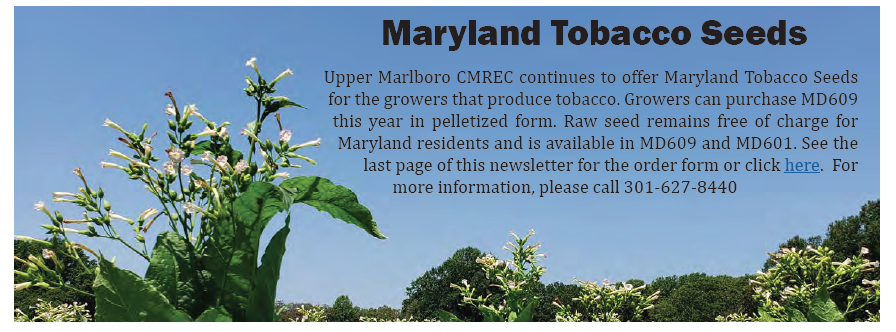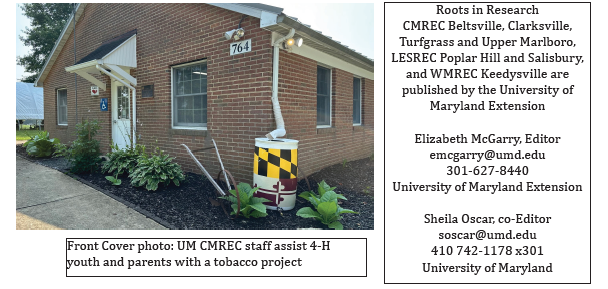'ROOTS IN RESEARCH' Newsletter
CMREC - Upper Marlboro Facility - Yield of 2022
2022 will definitely be a year to remember. Abundant rainfall and great growing conditions produced some of the highest crop yields we have ever had. Even more importantly, his past year marked the end of a career for two of our employees and the beginning of a new chapter for another. Bill Eversfield and Ronnie Wood both worked their last day for the University in 2022 and we thank them for their years of service. We were fortunate enough to hire back Michael Perise to fill the position vacated by Bill. You can read about Michael on page 3. Michael's passion for the crops that we grow is undeniable and he will help lead us into an even brighter future. As always, our Faculty, Staff, and students have worked tirelessly to bring this important information to you. Please enjoy this latest edition of Roots in Research while hopefully gaining some very useful knowledge. Donald Murphy, Facility Manager
_________________________________________________________________________________________________________________
Upper Marlboro Weather Station
Weather data for Upper Marlboro is displayed on our website from 1956 to current. The information can be displayed by month, or by the year in a printable format. To compare weather data averages by the month or year, check out our website! If your research requires this data in a different format, please contact Elizabeth McGarry (emcgarry@umd.edu) and she will help to get the information you are requesting.
__________________________________________________________________________________________________________________________________
CMREC Upper Marlboro Welcomes Back Michael Perise
Michael Perise of Huntingtown is a graduate of the University of Maryland in which he majored in Sustainable Ag at the Institute of Applied Agriculture, class of 2016. Michael is not new to the facility. During his time at UMD he was an intern here with the Terp Farm project Following his graduation, Michael worked for the College of Agriculture for 6 years at the Beltsville and Upper Marlboro facilities. His personal knowledge and background in tobacco, poultry and vegetable production made him a suitable fit for the facility. As a seasoned outdoorsman Michael does not shy away, partaking in diligent jobs that are essential in the daily operstions on the facility, in addition to doing a little fishing during his lunch breaks.
___________________________________________________________________________________________________________________________________
4-H Story for My 2022 Record Book, Excerpt Ashtyn DeVries, Calvert County 4-Her
Our Calvert County Heritage 4-H Club grew at the University of Maryland farm in Upper Marlboro, and learned all the steps to growing and harvesting tobacco. The project kicked off with Dave Conrad, retired UME tobacco specialist, coming to our club meeting and teaching us the history of tobacco. For planting, first off, you have to plant the seedlings. We used a machine where the plants go into a small slot then they are put into the ground. Read more>>
__________________________________________________________________________________________________________________________________
The Magical Lessons of Sweet Potatoes
Meredith B. Epstein, Senior Lecturer and Advisor, Sustainable Agriculture Epstein
Terp Farm and the Upper Marlboro Research and Education Center are always the first field trip of the year for students in INAG123 People, Planet & Profit: Digging Into Sustainable Agriculture. This course, taught by the Institute of Applied Agriculture, includes many students earning their two-year Certificate in Applied Agriculture, but also draws students from majors far and wide. INAG123 can satisfy one of the many General Education requirements that the University has for all degree-seeking students, and it can count toward the most popular minor on campus – Sustainability Studies. Read more>>
__________________________________________________________________________________________________________________________________
Evaluation of Hot-Set Tomato Cultivars to Fill the Summer Slump in Southern Maryland
Ben Beale, Extension Educator, St. Mary’s County, Alan Leslie, Extension Educator, Charles County
During the 2022 growing season, we trialed 15 tomato cultivars that show promise as varieties that will produce high yields during the hottest periods of field tomato production in Maryland. This trial builds upon initial work done in 2021, where 13 tomato varieties were trialed. This year we included two new varieties: Bejo 3353 (Patsy), and Dixie Red. Patsy is a new variety that was developed specifically for growing conditions on the East Coast, and we were hopeful that it would have the same disease resistance characteristics as Bejo 3345 (Carole), but maybe produce larger fruit. Read more>>
__________________________________________________________________________________________________________________________________
Using a Biostimulant, Silicon and Plant Resistance in Pumpkin Production Systems to Reduce Plant Disease Loss
Jerry Brust, IPM Vegetable Specialist
Objective: Evaluate a plant biostimulant (Stimplex) alone and in combination with silicon and powdery mildew resistance on foliar and soil borne diseases and yield of pumpkin.
Material and Methods: Two studies were conducted. The first study examined foliar disease problems. Treatments were: Stimplex, Calcium silicate and a powdery mildew resistant (tolerant) pumpkin variety (Charisma) vs. a similar non-resistant variety (New Rocket, same days to harvest and same wt per pumpkin as Charisma). Calcium silicate was applied at a rate of 4,000 lbs/a before bed formation to 4 rows in a plot (25x50 ft area). Lime was applied to the other 4 rows in a plot to bring soil pH up to 6.8-7.0. Read more>>
_________________________________________________________________________________________________________________
Environment, Technology, and Economy (ETE) Program of College Park Scholars Returned to CMREC for the 20th Year
Tim Knight , Director - Environment, Technology, and Economy, College Park Scholars
On August 26, 2022, the students of the Environment, Technology, and Economy (ETE) program of College Park Scholars returned to CMREC for the 20th year. Sponsored by the College of Agriculture and Natural Resources, ETE teaches incoming students about sustainability and food systems as they transition to the University of Maryland. To begin that process, we volunteer at CMREC and the nearby Clagett Farm, giving students a chance to form friendships even before classes start. Read more>>
___________________________________________________________________________________________________________________________________
Crops Twilight Tour and Ice Cream Social

The Crops Twilight Tour, Barbecue & Ice Cream Social was an absolute success with 94 in attendance!
The weather was pleasantly hot, nearly perfect for the evening activities and the wagon tour - The farm looked spectacular! Aspecial thanks to Donald, Alfred, and Ronald. The stops we made and pictures from the tour can be seen here: Crops Twilight Tour Aug 3, 2022___________________________________________________________________________________________________________________________________
Downy Mildew Resistant Basil Trial
Alan Leslie, Extension Educator, Charles County
Basil downy mildew (BDM) is a disease that was first reported in the United States in 2007. Prior to its introduction, basil plants could be reliably grown with little or no pesticide inputs. However, in late summer, BDM infection can devastate a basil crop and quickly render it unmarketable. We carried out a trial to test several varieties basil for their resistance to BDM infection during the summer. We tested six varieties with and without known resistance. Four varieties were developed from the Rutgers breeding program and have BDM resistance: Read more>>
___________________________________________________________________________________________________________________________________
UMD Bee Lab and the New UMD Bee Squad
https://www.umdbeelab.com/ https://umdbeesquad.com/
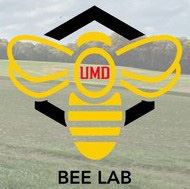 About The Lab
About The Lab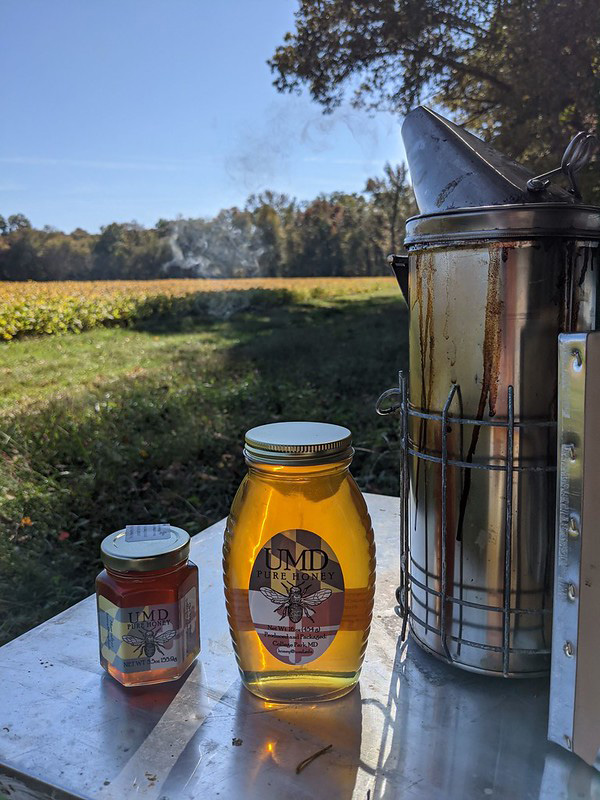
The Honey Bee Lab at the University of Maryland has diverse personnel with multidisciplinary scientific backgrounds who bring a fresh perspective to solving problems. Research in the laboratory is focused on an epidemiological approach to honey bee health. We are proud to share our research into the major mechanisms that are responsible for recurring high loss levels in honey bee populations, such as pests and pathogens associated with honey bees, loss of natural forage habitat due to large monocultural croplands, and pressure from human induced changes in the environment.
Our team has led and managed the USDA APHIS National Honey Bee Disease Survey since 2009. We are also a major partner and founding member of the Bee Informed Partnership (BIP), who collaborates closely with beekeepers from across the country to study and better understand the loss in honey bee colonies in the United States.
You can find Realtime results about these efforts at our database portals: https://research.beeinformed.org/state_reports/. Click here to purchase UMD Honey
Donations
If you are able to help support our mission to improve honey bee health, we greatly appreciate whatever you can give.
You may donate online using the University of Maryland "Giving to Maryland" Honey Bee Lab Donation Site. Thank you for your support!
_________________________________________________________________________________________________________________________________
Wednesday Water Webinars
Drinking Wells, Water Quality and Septic Systems
Andrew Lazur, Ph.D., State Extension Specialist - Water Quality - University of Maryland Extension,
University of Maryland Extension now hosts monthly Wednesday Water Webinars on various water quality related topics. Join Andy as he dives into water topics that affect us all. These webinars take place via Zoom from 12 - 12:40 PM, allowing time for Q & A at the end. Click on a title below to register, or if the date has past, the link will take you to the recording of that webinar, or check out our website for past recordings and more! Read more>>
___________________________________________________________________________________________________________________________________
Evaluation of New Artisan Type Tomato Cultivars in Southern Maryland, Year 2
Alan Leslie, Center Director WMREC, CMREC, LESREC
Growing heirloom tomatoes is an attractive option for local markets, because they offer superior flavor characteristics and typically produce fruit that are large with unique colors and shapes. In farmers markets, roadside stands, and CSAs, consumers will pay premium prices for good quality heirloom-type tomatoes. By definition, heirloom tomatoes are older varieties that are open pollinated and have indeterminate growth. Read more>>
___________________________________________________________________________________________________________________________________
Choosing What To Grow On Terp Farm
Guy Kilpatric, Terp Farm Manager
At the top of the list of frequently asked questions by people hoping to learn more about Terp Farm is about how decisions are made about what crops to grow. It’s a question that is usually preceded by asking what the farm currently grows - which in the present season consists of baby-leaf salad mix, basil, napa cabbage, daikon and storage radishes, sweet potatoes, watermelon, roma tomatoes, hot peppers, pumpkins, and several varieties of winter squash. At first, crop selection for the farm was an exercise in trial and error. Read more>> ___________________________________________________________________________________________________________________________________
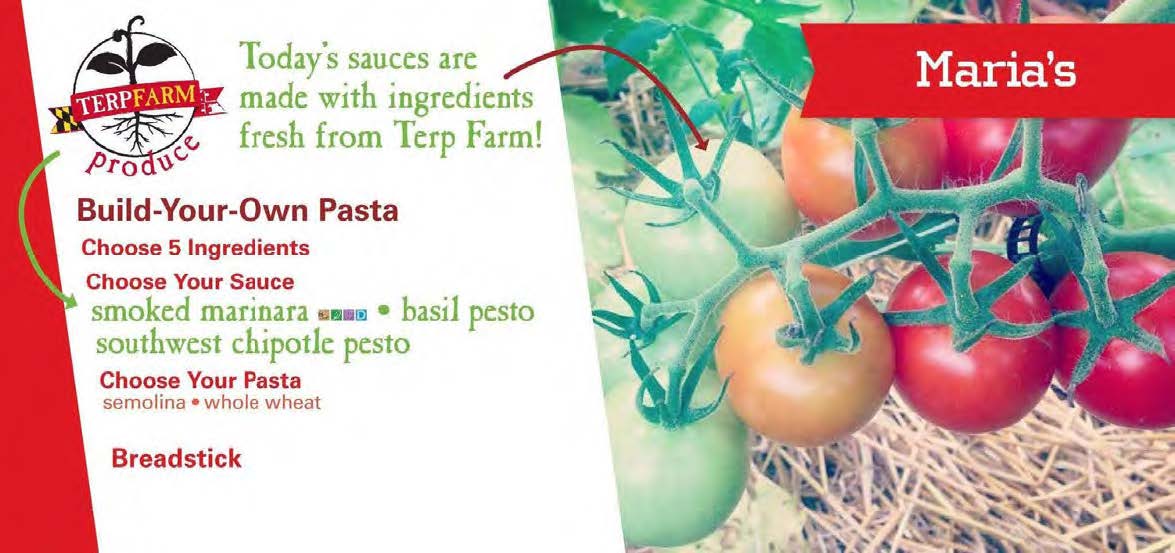
With visibility and recognition being important factors, it became clear that signature recipes containing Terp Farm products was the most conducive way to make those connections. So actually deciding what scale at which to produce a crop is now largely determined by how much of a said crop is needed to fulfill the recipe needs for the menu item associated with that crop. A perfect example of this is with the house-made pesto, which is now produced with virtually 100% Terp Farm basil. If every single menu item containing pesto throughout the entire school year is made from Terp Farm basil, then it becomes really simple to communicate the message that this food being eaten by Terps, was grown on a farm by Terps. Other recipe-based crop selections include napa cabbage and daikon radish grown specifically for kimchi, and roma tomatoes grown specifically for house-made marinara.
So if you ever find yourself dining on campus in one of the dining halls, look for some of these menu items and you will likely find a poster or menu card nearby that tells the story of how the food was grown at Terp Farm. Website: dining.umd.edu/terp-farm Email: terpfarm@umd.edu Instagram: @terp.farm
_________________________________________________________________________________________________________________________________
Evaluating Biosolarization, Cover Cropping and Strip Tillage as an Integrated Pest Management Tool in Eggplant
Dwayne Joseph - UME Educator, Kent County, Alan Leslie - UME Educator, Charles County, Kurt Vollmer - UME Specialist-Weed Management, Cerruti Hooks - Professor Department of Entomology, UMD
An integrated weed management approach is imperative in vegetable production. Fewer herbicides are registered in vegetables compared to row crops. Furthermore, many herbicides don’t offer full-season weed control and producers are at an increased risk of crop injury if not applied as labelled. Organic farmers consistently list weeds as a top production constraint as they invest great amounts of time and labor to manual and mechanical weed control. Our research has shown the utilization of a living mulch and strip-tillage increases weed control between rows however, the soil disturbance may lead to a weed flush within the cultivated row. Read more>>
__________________________________________________________________________________________________________________________________
Allele Frequencies of Culex Pipiens Bioforms Vary Across an Urban-to-Rural Gradient in Greater Washington D.C.
Arielle Arsenault-Benoit, Ph.D. Candidate, Sommer Stephens, AGNR SOARE Program, Megan L. Fritz, Assistant Professor, University of Maryland Department of Entomology
Landscape heterogeneity driven by land use, including urbanization, creates diverse habitat and resources for mosquito vectors of disease. Understanding the role of urbanization on mosquito vectors is important because vectors impact the dynamics of pathogen transmission to humans and pose risks to public health. Culex pipiens mosquitoes are important vectors of West Nile virus (WNv) in eastern North America, and are subjects of vector surveillance and abatement efforts across the region. All Cx. pipiens are associated with human land use. Within the species, there are two bioforms, Cx. pipiens f. pipiens and Cx. pipiens f. molestus, that demonstrate different behavioral, physiological, and ecological characteristics. Read more>>
___________________________________________________________________________________________________________________________________
Evaluating Late Season Burndown Options for Palmer Amaranth
Ben Beale, Extension Educator, St. Mary’s County, and Alan Leslie, Extension Educator, Charles County
A common question asked by farmers dealing with herbicide resistant Palmer amaranth is; What are the most effective burndown options in situations where Palmer amaranth is larger then the ideal 3-4 inch control range?” We often encounter this scenario in fields left fallow for a year, fields with delayed planting due to saturated soils, and double crop fields following wheat. Read more>>
____________________________________________________________________________________________________
Performance of Blackberry Varieties in Southern MD
Alan Leslie
Blackberries are a crop that holds potential for diversified fruit and vegetable operations in the Mid-Atlantic, with options for pick-your-own, direct sale, or wholesale outlets. In general, blackberries are well adapted to growing conditions throughout the Mid-Atlantic, but newer variety releases from state breeding programs in Arkansas and North Carolina have yet to be thoroughly tested in this area. Read more>>
____________________________________________________________________________________________________
